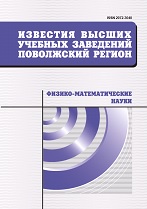|
Physics
On solving the inverse problem of acoustics for determining the average concentration of minerals on the ocean's bottom
E. M. Gvozdkova, I. Yu. Gryaznovaa, M. S. Labutinab
a Lobachevsky State University of Nizhny Novgorod, Nizhny Novgorod
b National Research University Higher School of Economics, Nizhny Novgorod
Abstract:
Background. With the increasing demands of industry for rare metals (such as lithium, cobalt, etc.) and in conditions of depletion of their deposits, more and more attention is being paid to the possibilities of extracting ore from the ocean's bottom. Under the conditions of increasing demands of industry for rare metals (such as lithium, cobalt, etc.) and in their deposits depletion, more and more attention is focused on the possibilities of extracting ore from the ocean's bottom Remote acoustic sounding of the ocean's bottom can serve as the simplest and most environmentally friendly way to detect underlying minerals for subsequent extraction. Remote acoustic sounding of the ocean's bottom could serves as the simplest and most environmentally friendly way to detect underlying minerals for subsequent extraction. An example of such minerals are iron-manganese nodules (IMN), which are investigated in this work. The investigating in this work iron-manganese nodules (IMN) is an example of such minerals. The researches conducted at the Department of Acoustics of the UNN has shown the possibility of determining the average concentration of discrete random inhomogeneities by the changes in the average intensity of the backscattered acoustic signal. The purpose of my research is to construct a backscattering model that takes into account the simultaneous influence of the characteristics of the surface underlying the scatterers and the uneven distribution of inhomogeneities over this surface to determine the concentration of particles according to acoustic measurements. Materials and methods. The physical model was considered within the framework of the theory of single scattering. The physical model was considered within the framework of the single scattering theory. The discrete inhomogeneities imitating the IMN were rigid spherical particles. Results. We investigated the influence of the reflecting properties of bottom rocks on the remote acoustic diagnostics of discrete random inhomogeneities located at the bottom. Also, in was constructed a backscattering model that takes into account the simultaneous influence of the characteristics of the surface underlying the scatterers and the uneven distribution of inhomogeneities over this surface. The obtained theoretical results were compared with experimental data, also it was considered the case of backscattering in the presence of diffusers of different sizes. Conclusions. The simulation results show that at low concentrations of scatterers, the presence of a reflected signal leads to a relatively large increase in intensity compared to the intensity of the signal reflected only from inhomogeneities. The simulation results is show that the low concentrations of scatterers, the reflected signal existence leads to a quite large intensity increasing with the comparing to the intensity of the signal reflected only from inhomogeneities A strong correlation between the positions of the diffusers significantly affects the magnitude of the average intensity of the received field compared to the case of a chaotic arrangement of inhomogeneities. The strong correlation between the diffusers' positions significantly affects to the magnitude of the average intensity of the received field compared to the case of a chaotic arrangement of inhomogeneities. If the scatterers have different sizes, a significant decrease in the interference term of the average backscattering intensity is observed. In case when the scatterers have different sizes, it is observed the significant decreasing of the interference term of the average backscattering intensity.
Keywords:
acoustic sensing, backscattering, average concentration, acoustic waves, discrete inhomogeneities, average intensity.
Citation:
E. M. Gvozdkov, I. Yu. Gryaznova, M. S. Labutina, “On solving the inverse problem of acoustics for determining the average concentration of minerals on the ocean's bottom”, University proceedings. Volga region. Physical and mathematical sciences, 2022, no. 3, 85–94
Linking options:
https://www.mathnet.ru/eng/ivpnz219 https://www.mathnet.ru/eng/ivpnz/y2022/i3/p85
|

| Statistics & downloads: |
| Abstract page: | 57 | | Full-text PDF : | 18 | | References: | 17 |
|




 Contact us:
Contact us: Terms of Use
Terms of Use
 Registration to the website
Registration to the website Logotypes
Logotypes







 Citation in format
Citation in format 